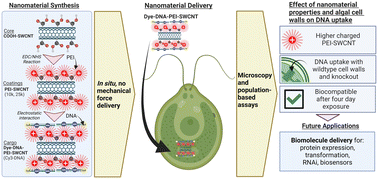DNA delivery by high aspect ratio nanomaterials to algal chloroplasts†
Abstract
Chloroplasts are sites of photosynthesis that have been bioengineered to produce food, biopharmaceuticals, and biomaterials. Current approaches for altering the chloroplast genome rely on inefficient DNA delivery methods, leading to low chloroplast transformation efficiency rates. For algal chloroplasts, there is no modifiable, customizable, and efficient in situ DNA delivery chassis. Herein, we investigated polyethylenimine-coated single-walled carbon nanotubes (PEI-SWCNT) as delivery vehicles for DNA to algal chloroplasts. We examined the impact of PEI-SWCNT charge and PEI polymer size (25k vs. 10k) on the uptake into chloroplasts of wildtype and cell wall knockout mutant strains of the green algae Chlamydomonas reinhardtii. To assess the delivery of DNA bound to PEI-SWCNT, we used confocal microscopy and colocalization analysis of chloroplast autofluorescence with fluorophore-labeled single-stranded GT15 DNA. We found that highly charged DNA–PEI25k-SWCNT have a statistically significant higher percentage of DNA colocalization events with algal chloroplasts (22.28% ± 6.42, 1 h) over 1–3 hours than DNA–PEI10k-SWCNT (7.23% ± 0.68, 1 h) (P < 0.01). We determined the biocompatibility of DNA–PEI-SWCNT through assays for living algae cells, reactive oxygen species (ROS) generation, and in vivo chlorophyll assays. Through these assays, it was shown that algae exposed to DNA–PEI25k-SWCNT (30 fg per cell) and DNA–PEI10k-SWCNT (300 fg per cell) were viable over 4 days and had little impact on oxidative stress levels. DNA coated PEI-SWCNT transiently increased ROS levels within one hour of exposure to nanomaterials (30–300 fg per cell) both in the wildtype strain and cell wall knockout strain, followed by ROS decline to normal levels due to reaction with antioxidant glutathione and lipid membranes. PEI-SWCNT can act as biological carriers for delivering biomolecules such as DNA and have the potential to become novel tools for chloroplast biotechnology and synthetic biology.

- This article is part of the themed collection: Nano-bio interactions


 Please wait while we load your content...
Please wait while we load your content...